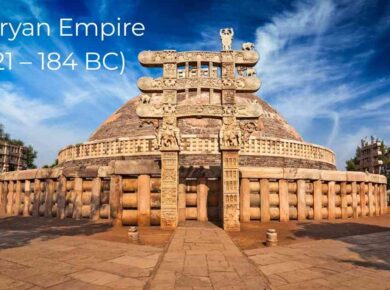Paleolithic age, Mesolithic Age, Neolithic Age, Chalcolithic Age
Quaternary Age
Evolution of its crust shows four stages, 4th stage being Quaternary, which comprises of:
- Pleistocene (20 Lakh – 10000 years)
- Holocene (10000 – Present)
Pleistocene Age
- Roughly dressed stone tools
- Crude chipping
- No knowledge of Cultivation
- Solely living on hunting
- Lived in rock-shelters.
“Also known as Paleolithic age or Ice age or Old Stone Age & divided into 3 ages”.
| Early/ Lower Paleolithic Age |
|
| Middle Paleolithic Age |
|
| Upper Paleolithic Age |
|
Bhimbetka Rock Shelters
- Bhimbetka rock shelters are located in Raisen District of Madhya Pradesh, 45 km south of Bhopal at the southern edge of the Vindhyachal hills.
- These served as shelters for Paleolithic age man for more than 1 lakh years.
- This is the most exclusive Paleolithic site in India which contains the rock carvings and paintings.
- These paintings belong to the Paleolithic, Mesolithic ages, Chalcolithic, early historic and even medieval times.
Bhimbetka is a World heritage Site. Please note that it was earlier considered to be a Buddhist site and was later recognized as Paleolithic site by Vishnu Shridhar Wakankar who is now also called “father of rock art in India”. Bhimbetka Rock shelters were included in the world heritage list in 1970.
Holocene: Mesolithic Age (9000 – 4000 BC)
- Marked by phenomenal changes in climate as climate became comparatively warm & dry which brought significant changes in flora & fauna and made it possible for humans to move to new areas.
- Characteristic tools of this Age: Microliths
- Transitional Phase between Paleolithic & Neolithic Age
- People mostly lived on Hunting, Fishing & Food gathering; At later stage also domesticated animals
- Rock Paintings from Paleolithic & Mesolithic age have been found at Bhimbetka caves (Painted birds, animals & humans)
Holocene: Neolithic Age (5000 – 1800 BC)
- Earliest farming communities → Characterized by cultivation of plants & domestication of animals.
- Earliest evident of Neolithic culture have been found at Mehragarh on bank of river Bolan (Baluchistan) 7000 BC showing beginning of agriculture & domestication of animals.
- Pottery 1st appeared in this phase → Black burnished ware + Course Grey ware pottery for cooking.
- Important Places: Gufkral (Cave of Potters) & Burzahom (Place of Birch)
- Dog burial with the master → Special feature of Burzahom
Holocene: Chalcolithic Age (1800 – 1000 BC)
- Marked by use of copper → 1st metal used in India.
- Cultivation & cattle rearing along with established the knowledge of crop rotation (@ Inamgaon),
- Knowledge of Irrigation & Harvesting
- Excavation reveals structures like Granaries, Embankment & Fortification
- Mud houses made of mud in circular & rectangular pattern along with mud chulha
- Culture was limited from Udaipur to Malwa & Maharashtra
- Famous Pottery of this age → Black on Red ware











6 comments
I am grateful for providing such essential information in such smaller notes, Really I gain a lot in lesser words.
Thank You!
An excellent effort but also include imp. excavation sites with maps of the above cultures ,these r also imp. for the point of view of exams.
Great
Great.
Good article but not so useful
its very useful for students which they are preparing.